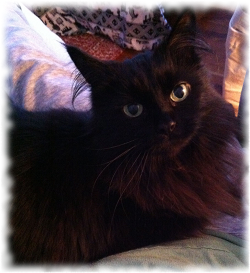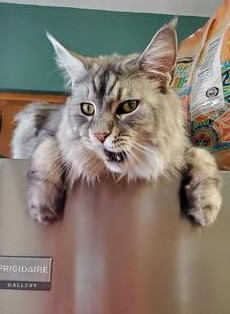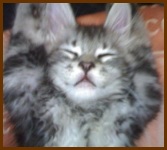- Home
- Maine Coon Cat Health
- Cat Oral Health
Disclosure: this site is reader-supported. When you buy through links on our site, we may earn a small commission, at no extra cost to you.
Maine Coon Cat Oral Health Care
Cat oral health and taking care of teeth is easy to forget!
Cats are great at hiding discomfort, and they dislike anyone prying their mouth open, so this is an easy cat care area to forget about.
Let's go over the basics of Maine Coon cat oral care.

There are common cat dental care issues, and some unusual ones.
For example, our little girl Alice had an unusual condition where she was allergic to her own saliva.
She had to have a couple of teeth removed at a young age, just a few years old - before most of us start thinking about brushing our cat's teeth, gingivitis, inflamed gums, or dental cleanings.
On our visitor Q & A page about teeth and gums, readers share experiences with rodent ulcers, luekoplakia, stomatitis, and kitten teething issues.
The vast majority of the cat oral health issues we might encounter are similar to human dental care issues - gingivitis, tartar and cavities in cats.
And these can be avoided in the same way we humans try to avoid them - by regularly brushing teeth.
Cat Oral Health Problems and What to Look For:
 Centauri Blu yawning
Centauri Blu yawningTry getting a peek inside their mouth when you can. When cuddling and sleepy, lift their lips for a moment.
Or, take a look when he or she has a big yawn, if possible.
Our beloved house cats come from ancestors who evolved to hide their pain, injury or discomfort from potential predators in the wild.
So it's up to us to notice the subtler signs that something is amiss:
- Gums should be pink and healthy-looking, not bright red or inflamed. Also, yellow tinged gums can signal liver problems - although that can be hard for the average cat owner to see.
- Teeth should be nice and white. You don't want to see the tell-tale yellow or brown of tartar buildup.
- Difficulty eating, especially kibble, or crunchy food or treats. Loss of appetite.
- Broken or loose teeth.
- Pawing at the mouth and drooling. Our Maine Coon girl did both of these things when she developed a mouth abscess.
Some common dental and cat oral health problems, besides gingivitis (which can be combated with brushing) include:
Cat tooth resorption: the cause of tooth resorption in cats is still unknown. It's signs include bright or bleeding red gums, drooling and difficulty eating. The inner material of the tooth, dentin, erodes.
I was surprised to learn that it is estimated to affect nearly 3/4 of cats over 5 years old. It's very painful, and a cat will suffer in silence, so those annual exams are very important. Treatment involves removing the tooth.
Periodontitis: A form of gum disease in senior cats when the ligaments and tissue around the tooth recede, exposing the root. Another painful issue needing extraction.
Gingivitis and Stomatisis: stomatisis is more common in cats that have FIV. It happens when bacteria spread throughout the mouth to the tissues in the cheeks and throat. Signs include redness in the tissues of the mouth and difficulty eating.
Cat Oral Health - Brushing Teeth:
There's no better time than the present to start a brushing routine!
Judy in UK (South England) asks:

Cleaning Buddy's Teeth
"Hi Carrie
Now Buddy is beginning to grow his adult teeth - here are my questions - I'd appreciate all the info I receive.
1. How long should I wait before starting a routine of cleaning his teeth?
2. What is the best way (for Buddy) for me to inspect and clean his his teeth?
3. How should I start?
I've a toothbrush and cat toothpaste (#affiliatelink) at the ready. One of the cats where I work had two teeth out - staff don't have the time to clean them. It was a salutary lesson for me."
Reply:
Hi Judy,
There is quite a bit to learn when it comes to cat health, and cat oral health. As for the mechanics of how and when to brush cats teeth, it is thankfully simple!
1) How long to wait: There is no perfect time to start brushing a kitten's teeth; go ahead and start your oral hygiene rituals anytime!
The sooner you start brushing his teeth, the sooner he'll get trained to tolerate (and maybe even enjoy) it.
2) The best way to check Buddy's teeth; To get a good look inside his mouth simply slide a finger inside his mouth at the side.
He'll let you have a quick look around. It's unlikely he'd have any areas of concern at his age (5 months) The next time you're at the vet, you'll see how he checks the teeth & gums.
3) How to start; just get that brush in there! You may not get much done the first few times, but he'll get used to it, and gradually you can have longer brushing sessions.
It might help to place him on our lap or for you to sit on the floor "behind" him so he can't back up to slide away.
Some Maine Coon friends on the site have suggested great tips and tricks, such as having a treat handy, such as some catnip in their other hand for a reward and distraction during their cat's tooth brushing time.
Have fun!
~Carrie
Dental Care for Cats:
We don't always think of our cats as needing dental care, but it's just as important for them as it is for us!
Regular dental care doesn't just keep their breath fresh; it prevents plaque buildup, gum disease, and even more serious health issues.
Being sedated for dental cleaning and possible tooth extraction is no fun for any cat! Sometimes it's unavoidable, but these tips can help keep that situation at bay.
5 Simple Steps for a Healthy Smile
Here are some practical tips and tricks that make keeping your cat's mouth in great shape a little easier:
1. Establish a Routine—Start Slow and Stay Consistent
When it comes to brushing, consistency is key! Aim for 2–3 times per week to keep plaque in check.
Start slowly by introducing them to the toothbrush or finger brush. Let them sniff it, then ease into brushing by applying a small amount of cat-safe toothpaste (avoid human toothpaste, as it can be harmful to cats!).
Keep the sessions short and reward them with a treat or extra love to help them associate tooth brushing with positive outcomes.
2. Choose the Right Tools
The right toothbrush and toothpaste make all the difference. Cat-specific toothbrushes are designed with soft bristles that are gentle on their gums, and many come in smaller sizes to fit their little mouths.
You can also find finger brushes that might be easier to maneuver.
Cat toothpastes come in flavors like chicken or fish, which they tend to like more than the minty flavors we’re used to.
Finding a flavor they enjoy can make them much more willing to cooperate!
3. Add Dental Treats and Chews to Their Diet
Look for dental treats and toys designed to help with plaque buildup.
Some treats are made with textures that encourage chewing, which can help scrub away at plaque naturally.
Dental chews are also great for cats who aren't fond of brushing (or for a little extra help in between brushings).
Remember, while treats can be helpful, they aren’t a replacement for brushing—they’re more like an extra boost!
4. Try Dental Toys for Extra Help
There are plenty of toys that double as dental aids, designed with textured surfaces that naturally massage the gums and clean the teeth while your cat plays.
Catnip-stuffed dental toys or rubber chew toys can keep your kitty entertained while they get a bit of a teeth-cleaning boost. Plus, they're perfect for cats who love a good chew session!
5. Know the Signs of Dental Trouble
Even with regular brushing, it's helpful to know when something's off.
If you notice symptoms like
- drooling
- difficulty eating
- red or swollen gums
- bad breath that won't go away
it might be time to have your vet take a look.
Dental health impacts overall health, so catching issues early can make a big difference!
Taking care of your cat's teeth may feel a little daunting at first, but with these simple tips and tools, it's easier than you'd think.
Happy brushing, and here's to a healthy, purr-fect smile!
« Back to Maine Coon Health
Disclosure: this site is reader-supported. When you buy through links on our site, we may earn a small commission, at no extra cost to you.
Sources:
Keeping Your Cat’s Mouth Healthy. (2018). Hillspet.Com. Retrieved October 15, 2021, from https://www.hillspet.com/cat-care/routine-care/cat-teeth-and-oral-care
Tooth Resorption in Cats. (2021). Vca_corporate. Retrieved October 15, 2021, from https://vcahospitals.com/know-your-pet/tooth-resorption-in-cats



